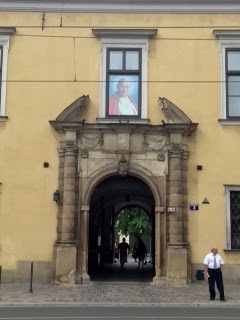Cidade/city: Cracóvia/Krakow
Com as dicas do Marcin que é polonês, tive a oportunidade de conhecer essa cidade linda que é a Cracóvia. É uma cidade muito viva e alegre, fazia muito calor e todos se concentravam em volta da praça central.
(Marcin, who is Polish, gave me lots of tips about Krakow so I could visit many beautiful places. It is a lively and nice city.)
Essa é a igreja de Santa Maria e a praça principal.
(It is St. Mary's church and main market square)
(This city became famous because it is the place where the former pope John Paul II lived).
Foi aqui que conheci uma forma diferente de turismo: free guide tour, que é conhecer a cidade com um guia e no final você dá o quanto quiser.
(It was here that I came across this different way of sightseeing: free guide tour, they show you the city and you give them a tip at the end).
Esse é o palácio real, ou castelo de Wawel, que serviu de residência a família real.
(This is the Royal palace or Wawel Castle, the residence of queens and kings.)
Estava tendo uma feira onde mostravam o dia a dia na antiga Polônia, com música e comida típica.
(There was a fair where they were showing Polish costumes with typical music and food.)
(There was a fair where they were showing Polish costumes with typical music and food.)
Lugar/place: Mina de Sal Wieliczka - Salt Mine.
A mina foi construída no século 13 e produziu sal até 2007. Existem lá muitas estatuas, tres capelas e uma catedral, que foram cavadas das pedras de sal pelos mineiros.
A mina tem uma profundidade de 327 metros e mais de 287 kilometros.
(The mine was built in the 13th century and produced table salt until 2007. There are dozens of statues, three chapels and a cathedral that has been carved out of the rock salt by the miners.
The mine reaches a depth of 327 meters, 1073 ft, and is over 287 kilometers long, 178 miles.)
Lugar/place: Auschwitz - campo de concentração / Concentration camp.
Foi o maior campo de concentração construído, 1941-1945, mais de 1.1 milhão foram mortos. Aproximadamente 90% dessas pessoas eram judeus. A maioria foi morta na câmara de gás, outros por fome, por excesso de trabalho... Esse é um dos lugares mais horrorosos, mas emocionante de ser visitado!
(It was the largest of Nazi Germany's Concentration camp, 1941-1945, and 1.1 milion of people were killed. About 90% of them were Jews. Most of the dead were killed in gas chambers, others by starvation, forced labor... It is one of the most terrifying places in the world to visit, but also touching!)
Era por essa linha de trem que os judeus chegavam para serem executados. Visitamos os pavilhões onde são expostos seus pertences. Muito chocante...
(The Jews were brought here by train... to die. We visited these rooms where their belongs are shown. It is very touching...)
(The Jews were brought here by train... to die. We visited these rooms where their belongs are shown. It is very touching...)
 |
| Os sapatos deixados após a execução... (The shoes left after their execution...) |











Nenhum comentário:
Postar um comentário